LABOUR WELFARE & INDUSTRIAL RELATIONS
Paper – II
Note : This paper contains fifty (50) objective type questions of two (2) marks each. All questions are compulsory.
1. Which of the following statements are true about Herbert A. Simon’s decision making process ?
a. Decision-making process involves intelligence, design and choice activities.
b. Decision-making involves choice between alternative plans of action.
c. Bounded rationality has no significance in decision-making process.
d. Satisficing model brings about a balance between individual and organisational value judgement in decision making process.
(1) a and b are only true.
(2) a and d are only true.
(3) a, b and c are true.
(4) a, b and d are true.
2. Which of the following statements about communication is/are either true or false ?
a. Gang plank theory of Henry Fayol is an example of vertical communication.
b. Encoded messages are not always decoded effectively because of different fields of organism.
c. ‘Filtering’ is not an intervention which vitiates communication.
d. ‘Grapevine’ communication moves faster than formal communication.
(1) a and c are true; b and d are false.
(2) a and d are true; b and c are false.
(3) b and d are true; a and c are false.
(4) a, b and c are true; and d is false.
3. Which of the following is the correct formula for calculating the direct group relations of ‘span of control’ as given by V.A. Garicuna ?
(1) ![]()
(2) 
(3) 
(4) 
4. Match List ‘A’ with List ‘B’ and choose the right answer by using the codes given :

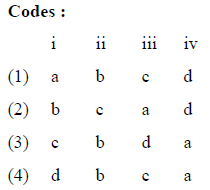
5. Which of the following pair is correctly matched ?
(1) F.W. Taylor – Human Relations Approach
(2) Henry Fayol – Universality of Management
(3) Elton Mayo – Psychological Approach
(4) M. Parker Follet – Scientific Management
6. Read the following and mark your answer according to the answer code given below :
Wage incentive plans have the following objects :
(a) Increasing workers morale
(b) Lowering unit cost
(c) Lowering capital cost
(d) Lowering depreciation charges
Answer code :
(1) a & d are correct.
(2) a & c are correct.
(3) a & b are correct.
(4) c & d are correct.
7. Match the following selection errors (List – I) with their descriptions (List – II) :

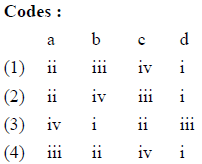
8. Assertion (A) : Competency based job analysis describing jobs in terms of measurable, observable, and behavioural competencies is currently gaining importance.
Reason (R) : Re-engineering redesigns the business process in such a manner that small multi-disciplinary self-managing teams get the task done together through multi-skilled competencies.
(1) Both (A) and (R) are wrong.
(2) (A) is right and (R) is wrong.
(3) Both (A) and (R) are right and (R) explains the (A).
(4) Both (A) and (R) are right, but (R) does not explain the (A).
9. Arrange the following steps in disciplinary procedure in their right order :
(a) Framing and issue of charge sheet
(b) Domestic enquiry
(c) Preliminary enquiry
(d) Reporting of misconduct to disciplinary authority
(e) Notice of enquiry
(f) Findings of enquiry officer
(g) Examination of evidences
(h) Closure
(1) d, e, a, c, b, g, h, f
(2) d, c, a, e, b, g, h, f
(3) d, e, a, c, b, g, f, h
(4) d, a, c, e, b, g, f, h
10. Who among the following is associated with the types of personnel department such as independent, integrated; staff-coordinated and split function categories ?
(1) Dale Yoder
(2) Dale S. Beach
(3) Richard P. Calhoon
(4) Dalton E. McFarland
11. Assertion (A) : Chronological age is rather crude measure of time since birth which can hide a multitude of individual differences in vigour, energy, enthusiasm, fitness, and so on. However, cognitive age could be a facet of personality related to openness to experience.
Reason (R) : Consumer psychology provides evidence that cognitive age is a much better guide to people’s buying habits, leisure pursuits, and so on than chronological age.
Codes :
(1) (A) is true, (R) is not true.
(2) (A) and (R) both are true. (R) explains (A).
(3) (A) and (R) both are true. (R) does not explain (A).
(4) (A) is not true, (R) is true.
12. Assertion (A) : Each role must have enough stressers which may help the role occupant to stretch himself/herself to meet the challenge. In the role where the scope is limited to routine work, the role occupants do not perceive any challenge.
Reason (R) : While every role has some routine elements, challenge can also be incorporated into every role. However, the challenge should not exceed an optimal limit, otherwise it may produce dysfunctional stress, resulting in poor performance or damage to the health of the employee in the long run.
Codes :
(1) (A) and (R) both are true, (R) does not explain (A).
(2) (A) and (R) both are true, (R) explains (A).
(3) (A) is true, (R) does not explain (A).
(4) (A) is not true, (R) explains (A).
13. A situation which refers to the consequences that different conflict handling strategies may have antecedent conditions. It may either resolve the conflict or make for future conflict.
This may be termed as :
(1) Behavioural view of conflict
(2) Conflict containment strategy
(3) Conflict Aftermath
(4) Conflict Manifestation
14. Following are the probable errors committed during organizational processes :
(i) leniency or severity error
(ii) primacy and recency effects
(iii) Halo effect
(iv) Spill over effect
(v) Status effect
(vi) Perceptual set
Which of the following statements is/are true/false ?
a. (i), (ii), (iii) are recruitment errors.
b. (i), (ii), (iii) are recruitment errors and (iv), (v) and (vi) are rating errors.
c. All are rating errors.
d. None are recruitment errors.
Codes :
(1) b is true, d is false.
(2) a is false, c is true.
(3) c is true, a is false.
(4) c and d are true, a and b are false.
15. Which of the following methods of training is also known as ‘socio-drama’ or ‘psychodrama’ ?
(1) Strategic planner
(2) Mirroring
(3) Apprenticeship
(4) Role-playing
16. Consider the following :
a. Structural Analysis
b. Interaction Analysis
c. Life position Analysis
d. Environmental Analysis
e. Dispositional Analysis
f. Coping Behaviour Analysis
Which among the above are the components of Dr. Eric Berne’s Transactional Analysis Theory ?
(1) c, d and e
(2) a, c and e
(3) a, b and c
(4) b, c and e
17. FIRO-B was developed by William Schutz in late 1950s, and is based on the theory of interpersonal relations.
FIRO-B stands for :
(1) Fundamental Interpersonal Response in organisations – Behaviour
(2) Feelings in Interpersonal Relations Openness – Behaviour
(3) Fellow Interpersonal Response in Organisation – Behaviour
(4) Fundamental Interpersonal Relations Orientation – Behaviour
18. Blake and Mouton proposed famous managerial Grid with ‘task orientation’ and ‘people orientation’ as two independent dimensions.
Identify the correct numerical denotions of the managerial styles given below :
a. Team management
b. Impoverished management
c. Country club management
d. Middle of the road management
e. Authority compliance
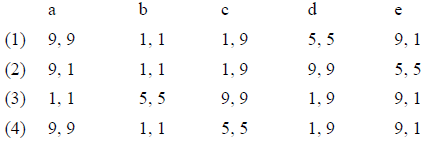
19. Assertion (A) : From its inception, the study of organisational change has noted the fact that many participants respond with dogged resistance to altering the status quo. Since the industrial revolution began, workers have at times sought, occasionally in extremely violent fashion, to block the introduction of new technology.
Reason (R) : Such behaviour may be either overt or covert. Overt resistance may take the form of employees deliberately failing to do the things necessary for successful change or simply being unenthusiastic about the change.
Covert resistance can be more detrimental to change than open resistance because it is harder to identify and eliminate.
Codes :
(1) (A) is true, (R) is false.
(2) (A) is true, (R) explains (A).
(3) (A) and (R) both are false.
(4) (A) is true, (R) does not explain (A).
20. The conceptual foundation of OB are anchored in the Behavioural Sciences of Psychology, Anthropology, and Political Science. Match the Behavioural Science Source (List – B) of the OB Topics (List – A).

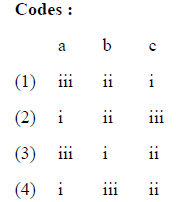
21. According to Sidney and Beatrice Webb, which of the following methods is/are employed by the trade unions to achieve their objectives ?
a. Mutual Insurance
b. Protective Labour Legislation
c. Collective Bargaining
(1) Only a
(2) a and b
(3) a, b and c
(4) Only b
22. The first of May in 1927 was for the first time celebrated as ‘Labour Day’ at
(1) Calcutta
(2) Bombay
(3) Madras
(4) Ahmedabad
23. Who started the publication of the Bengali Weekly, titled ‘Janawani’ in Calcutta ?
(1) Shapurji Bengalee
(2) M.N. Roy
(3) Muzaffar Ahmad
(4) Diwan Chamanlal
24. According to the Second National Commission on Labour, ‘check-off system’ must be made compulsory for members of all registered trade unions in establishments employing :
(1) 150 workers
(2) 200 workers
(3) 250 workers
(4) 300 workers
25. Under which type of Union Security, an employee in the bargaining unit is obliged to pay dues to the union in return for the collective bargaining service which it is rendering to him, although he does not join the union ?
(1) Preferential union shop
(2) Closed shop
(3) Agency shop
(4) Union shop
26. The Ahmedabad Textile Labour Association is an example of
(1) Craft Union
(2) Staff Union
(3) Industrial Union
(4) General Union
27. Which of the following is a non-statutory adhoc body ?
(1) Central Implementation and Evaluation Committee
(2) Central Committee on Labour Research
(3) Committee on Conventions
(4) Wage Board
28. Which of the following statements relating to the First National Commission on Labour is correct ?
(1) The Commission submitted its report in 1968.
(2) The Commission recommended that it would not be desirable to make union recognition compulsory under a Central Law.
(3) The Commission recommended that it would be desirable to make union recognition compulsory under a Central Law.
(4) The Commission recommended that a trade union seeking recognition should have at least 20 percent membership of the workers of an establishment.
29. There exists hurdles on the way of healthy growth of collective bargaining in India. Which among the following are not the hurdles of collective bargaining ?
a. Conditions of workers
b. Promotion of lasting industrial peace
c. Voluntariness in recognition of Union
d. Ineffective procedure for determination of representative union.
e. Provision for elaborate Adjudication machineries.
f. Comprehensive coverage of labour laws.
Codes :
(1) a and b
(2) c and d
(3) e and f
(4) c and e
30. Which of the following statements relating to the participation of workers in Management Bill, 1990 is not correct ?
(1) The Bill was introduced in the Lok Sabha on the 30th May, 1990.
(2) The introduction of this Bill was the first comprehensive legislative effort towards the promotion of workers’ participation in management in India.
(3) The Bill envisaged a three-tier system of workers’ participation in management.
(4) The Bill provided for the appointment of Inspectors and specified penalties for violating the provisions of the Act when enacted.
31. Which of the following is the prescribed qualification for appointment of a judge of an Employees’ Insurance Court under the Employees’ State Insurance Act, 1948 ?
(1) A judge of the High Court.
(2) Any presiding officer of a labour court with five years of experience.
(3) Any presiding officer of an Industrial Tribunal with three years of experience.
(4) Any person who is or has been a judicial officer or is a legal practitioner of five years standing.
32. Which of the following is true relating to appointment of Site Appraisal Committee under the Factories Act, 1948 ?
(1) State Government may appoint it.
(2) Both State Governments and Central Government can appoint it.
(3) State Governments may appoint it in consultation with the Central Government.
(4) Central Government may appoint a Committee for each State in consultation with the respective State Governments.
33. Social security provided by a ‘means test’ is called
(1) Need based assistance
(2) Social assistance
(3) Social assurance
(4) Mutual assistance
34. Which of the following statements are true relating to payment of equal pay for equal work both for men and women ?
a. ILO adopted equal remuneration convention No 100 in 1951
b. India ratified ILO’s Equal Remuneration Convention 100 in the year 1956
c. Provisions relating to equal pay for equal work for both men and women are provided under Article 42 of the Indian Constitution
d. The Equal Remuneration Ordinance was promulgated on 26th September, 1975
(1) a and d are correct.
(2) b and c are correct.
(3) a, c and d are correct.
(4) a, b and d are correct.
35. Match the provisions provided under Column-A with the respective legislations under which they are covered under Column – B :


36. An employee working in an organisation draws a salary of Rs.20,000/- per month. What is the amount of bonus that he shall be paid at the minimum rate of 8.33% under the payment of Bonus Act, 1965 ?
(1) Rs.20,000
(2) Rs.8,333
(3) Rs.7,000
(4) Rs.3,500
37. Under the provisions of the Payment of Wages Act, 1936, for which of the following organizations, the Central Government is the appropriate Government ?
a. Railways and Air Transport
b. Port and Docks
c. Mines and Oilfields
d. Public Sector banks
Codes :
(1) a and c only
(2) b and d only
(3) a, b and c only
(4) a, b, c and d
38. With regard to the reference of industrial disputes, where State Government is the appropriate Government to different authorities, which of the following statements is false ?
(1) Refer the dispute to a Board for promoting settlement thereof.
(2) Refer the dispute relating to any matter specified under second schedule to a labour court for adjudication.
(3) Refer the dispute relating to any matter specified in the Second Schedule or Third Schedule to a Tribunal for adjudication.
(4) Refer the dispute relating to any matter specified either in Second Schedule or Third Schedule to the National Tribunal for adjudication.
39. Which of the following are ad-hoc bodies under the Industrial Disputes Act, 1947 ?
a. National Tribunal
b. Labour Court
c. Industrial Tribunal
d. Court of Inquiry
e. Grievance Redressal Committee
(1) a, c and d
(2) a, d and e
(3) d and e
(4) a and d
40. What is the current wage ceiling per month for a person employed on a wage or salary to be considered as an employee under the Payment of Bonus Act, 1965 ?
(1) Not exceeding ten thousand rupees
(2) Not exceeding twenty-one thousand rupees
(3) Not exceeding eight thousand rupees
(4) Not exceeding eighteen thousand rupees
41. Assertion (A) : Competitive labour markets can be efficient.
Reason (R) : labour market participants in search of their own selfish goals attain such conditions.
Codes :
(1) (A) is right and (R) explains (A).
(2) (A) is right but (R) does not explain (A).
(3) (A) is wrong and (R) is right.
(4) Both (A) and (R) are wrong.
42. Match the following situations with effects :


43. Which of the following statements is not correct ?
(1) Labour market equilibrium assumes that markets adjust instantaneously.
(2) Equilibrium always prevails in labour market.
(3) Wages and employment change swiftly from old equilibrium level to new equilibrium level.
(4) Market of highly skilled workers exhibit systematic periods of booms and busts.
44. Who among the following viewed unemployment as outcome of the disorganization of economic system ?
(1) Keynes
(2) Lioneal Edie
(3) Karls Pribram
(4) Fairchild
45. Which among the following conditions will not lead to decrease in supply of labour :
(1) An increase in the wages paid in other occupations for which the worker in a particular market are qualified.
(2) An increase in the income other than employment.
(3) An increase in the people’s preferences for work in relation to leisure.
(4) A worsening of non-wage aspects of job.
46. The conceptual framework of Labour Welfare is contained in various theories of Labour Welfare. In the names of the theories given below, pick the wrong ones :
a. The Trusteeship Theory
b. The Placating Theory
c. The Need Theory
d. The Friendship Theory
e. The Public Relations Theory
f. The Functional Theory
Codes :
(1) a and b
(2) c and d
(3) e and f
(4) b and e
47. Match the following :

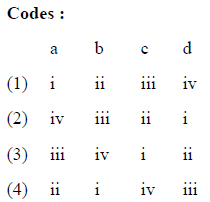
48. Assertion (A) : The social concept of welfare implies the welfare of man, his family and his community.
Reason (R) : All the three work together, or individually supplement one another, in a three-dimensional approach, each serving as ends and means.
Codes :
(1) (A) is wrong and (R) is correct.
(2) (R) does explain (A) properly.
(3) (R) does not provide proper explanation of (A).
(4) Both (A) and (R) are wrong.
49. The Directive Principles of state policy, as Contained in the Constitution of India, contains Articles incorporating provisions for Labour Welfare. Which among the following Articles does not contain provisions for Labour Welfare :
(1) Article 38
(2) Article 39
(3) Article 40
(4) Article 41
50. There exist provisions of statutory welfare facilities under various labour legislations.
Match them :
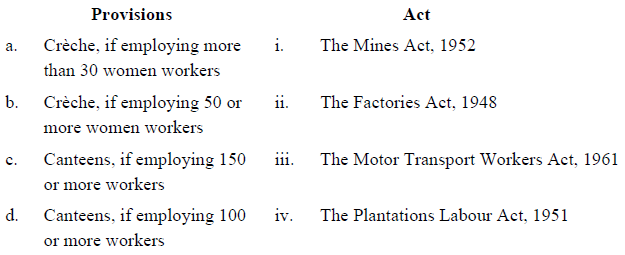
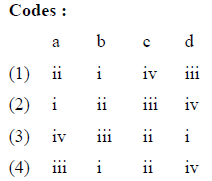
Latest Govt Job & Exam Updates: